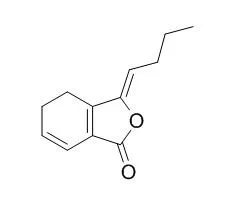| In vitro: |
| Sichuan Da Xue Xue Bao Yi Xue Ban. 2015 Jan;46(1):42-6. | | [Protective effect of ligustilide against low potassium induced apoptosis in cultured rat cerebellar granule neurons].[Pubmed: 25807794] | To investigate the effect of Ligustilide (LIG) on low potassium-induced apoptosis in primary cultured cerebellar granule neurons (CGN).
METHODS AND RESULTS:
Apoptosis was induced by low potassium in cultured neonatal rat CGN in vitro. The CGN was divided into control/model/CGP54626 + Ligustilide and Ligustilide group. The neuronal viability of each group was measured by MTT assay. The protein expression levels of the key insulin-like growth factor 1 (IGF)-1 signaling effectors,including the phosphorylated IGF-1 receptor (IGF-1R), Akt, ERK1/2, CREB and activated caspase 3 were examined by Western blot analysis. Ligustilide ranging from 2.5 to 20 micromol/L could protect against low potassium-induced apoptosis of CGN ini a concentration-dependent manner. 20 micromol/L Ligustilide significantly induced upregulation of the phosphorylated levels of IGF-1, Akt, ERK1/2 and CREB, and downregulation of cleaved-caspase 3 expression, which could be blocked by a selective gamma-aminobutyric acid B (GABAs) receptor antagonist CGP54626.
CONCLUSIONS:
Ligustilide concentration-dependently protects against low potassium-induced apoptosis in CGN at least partly through GABAa receptor activation and its downstream IGF-1 signaling pathway. | | J Ethnopharmacol. 2007 May 22;111(3):677-80. | | Relaxation effects of ligustilide and senkyunolide A, two main constituents of Ligusticum chuanxiong, in rat isolated aorta.[Pubmed: 17222996 ] | Ligusticum chuanxiong Hort. (Umbelliferae) is a widely prescribed traditional Chinese medicinal herb for cardiovascular diseases in China. However, the cardiovascular actions of Ligustilide and senkyunolide A, two of the most abundant Ligusticum chuanxiong constituents, have yet to be examined.
CONCLUSIONS:
The objective of the present study was to investigate the vasorelaxation effects of Ligustilide and senkyunolide A and their underlying mechanisms in rat isolated aorta. Both constituents had similar relaxation potencies against contractions to 9,11-dideoxy-9alpha,11alpha-methanoepoxyprostaglandin F(2alpha), phenylephrine, 5-hydroxytryptamine and KCl. Their vasorelaxation effects were not affected by endothelium removal, the adenylate cyclase inhibitor 9-(tetrahydro-2-furanyl)-9H-purin-6-amine, the soluble guanylate cyclase inhibitor 1H-[1,2,4]oxadiazolo[4,3-a]quinoxalin-1-one, or the non-selective K+ channel blocker tetraethylammonium.
CONCLUSIONS:
This is the first report to demonstrate the vasorelaxation activities of Ligustilide and senkyunolide A in contractions to various contractile agents in rat isolated aorta. The underlying mechanisms await further investigations. |
|
| In vivo: |
| Brain Res. 2015 Jan 21;1595:19-28. | | Ligustilide prevents cognitive impairment and attenuates neurotoxicity in D-galactose induced aging mice brain.[Pubmed: 25446001] | Ligustilide (LIG) is a principal active ingredient of traditional Chinese medicine, Radix Angelica sinensis, which has versatile pharmacological activities including neuroprotection. Previous studies have demonstrated that Ligustilide has beneficial effects on cognition deficits associated with cerebral damage or neurodegenerative disorders. In present study, we investigated the neuroprotective effect of Ligustilide on cognitive impairment and neurotoxicity in the brain of aging mouse induced by d-galactose (d-gal).
METHODS AND RESULTS:
The aging model mice were induced by subcutaneous (S.C.) injection of d-gal once daily for 8 weeks and Ligustilide (80 mg/kg) was simultaneously administered orally. The Morris water maze (MWM) test was used to assess the spatial learning and memory abilities. The activity of Na(+)-K(+)-ATPase and the content of lipid peroxidation product malondialdehyde (MDA) in brain were examined. The levels of glial fibrillary acidic protein (GFAP), growth-associated protein GAP-43, and cleaved caspase-3 in brain were also determined by immunohistochemistry. The MWM test showed that Ligustilide administration markedly improved behavioral performance of d-gal treated mice. This action could be partly explained by the results that Ligustilide reduced the level of MDA as well as increased the activity of Na(+)-K(+)-ATPase in the brain of d-gal induced aging mice. Moreover, Ligustilide significantly raised the expression of GAP-43 and reduced cleaved caspase-3 and GFAP levels in the brain of d-gal treated mice.
CONCLUSIONS:
These results demonstrated that Ligustilide improves d-gal-induced cognitive dysfunction and brain toxicity, which suggests that Ligustilide may be developed as a new medicine for the treatment of aged-related conditions. |
|






 Cell. 2018 Jan 11;172(1-2):249-261.e12. doi: 10.1016/j.cell.2017.12.019.IF=36.216(2019)
Cell. 2018 Jan 11;172(1-2):249-261.e12. doi: 10.1016/j.cell.2017.12.019.IF=36.216(2019) Cell Metab. 2020 Mar 3;31(3):534-548.e5. doi: 10.1016/j.cmet.2020.01.002.IF=22.415(2019)
Cell Metab. 2020 Mar 3;31(3):534-548.e5. doi: 10.1016/j.cmet.2020.01.002.IF=22.415(2019) Mol Cell. 2017 Nov 16;68(4):673-685.e6. doi: 10.1016/j.molcel.2017.10.022.IF=14.548(2019)
Mol Cell. 2017 Nov 16;68(4):673-685.e6. doi: 10.1016/j.molcel.2017.10.022.IF=14.548(2019)